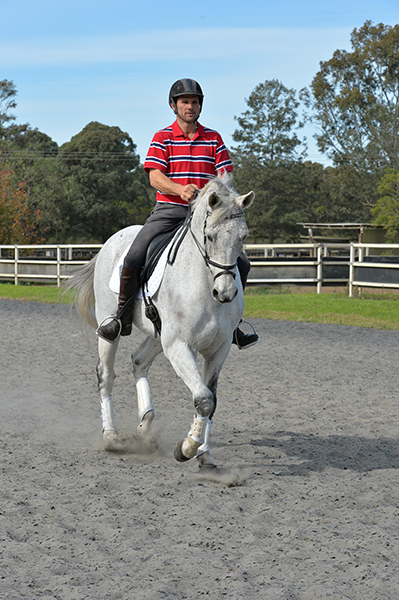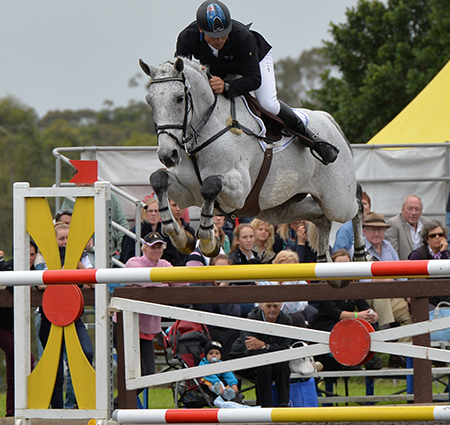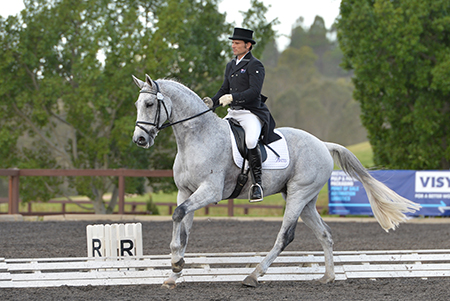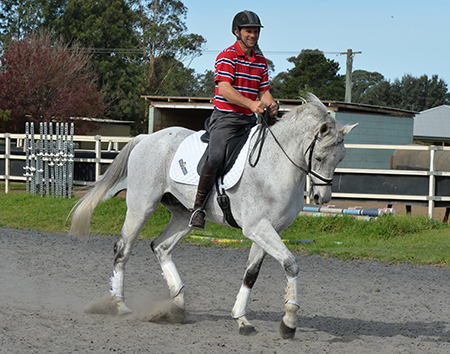It was a great opportunity to catch up with Shane Rose a couple of weeks after his 2014 Sydney CCI*** Star triumph, and talk about what it takes to train a 4-star star…

Shane and “Darcy”, showing collected work
Qualified came to you as a failed showjumper from a pretty professional showjumping stable, how do you manage to leave the poles up in the showjumping round?
“I really just try to keep him happy, I don’t try and trick him. I think I give him more enthusiasm than the showjumpers would. I think the showjumpers like to canter them down to the fence and let the horse produce a jump, if you canter him with a nice canter and get to the fence and let him do it, he sometimes pushes them out. George Sanna is a great trainer and he would have tried many things to make him jump well, but we just try to keep him happy. I think the other thing that has made a massive difference is the cross country, if he hits one of them, it does hurt, so he probably has a little more enthusiasm for his jumping…”
What does Qualified’s weekly routine look like?
“He has just come back into work, he had three weeks off after Sydney, of all my horses, I probably jump him the least. I try and keep him jumping fresh – obviously I need to do enough to keep him fit, but I don’t jump him as regularly as I do my other horses, he might only jump once a week, once a fortnight, certainly not two or three times a week. Like all the horses, when he is in a prep for a three day event and they start galloping, he gallops every fourth or fifth day, depending on the events and how they fit in. We school him on the flat in between, and he jumps once a week, although some weeks he doesn’t jump.”

The pair had one rail in the showjumping, enough to secure the victory at the 2014 Sydney 3DE
Do you use the racetrack?
“With him, yes. I do some of my gallops here. Leading into Sydney, which is very hilly, I did the majority of my gallops on the hill. On the bigger types of horses like him, or Taurus to a degree – he’s not as big but he’s another Warmblood – I tend to do more on the hill and get the weight off their front end, and also I can stress them a bit more. But galloping here on the flat is also great because it gives the Warmbloods the stamina that they don’t have, as opposed to the cardio-vascular. With the Warmbloods, it is as much about an all-round fitness, as opposed to the Thoroughbreds. With the Thoroughbreds, if you canter them around the paddock four times, they are ready to go, with the Warmbloods it is not only building the strength, but the aerobic and anaerobic capacity and the miles in their legs, so I do as many or more gallops here on the flat. Leading up to an event like Melbourne, I would probably do more on the flat than I would on the hill.”
“He has not got a special program, he’s a pretty routine kind of a horse, he’s got to get stronger on the flat like most of them. He’s done four three-day events now and the more he does, the better he goes. Every time he has gone out, he has got better and he continues to improve. Leading forward to Normandy, should I get selected, I am really confident he’ll improve again…”
I think I said it to you at Sydney, you rode the dressage test on Qualified more decisively than I have ever seen you ride a dressage test before, you were really sitting in there and asking, rather than hovering and hoping…
“He’s great to ride on the flat, in all disciplines, he is not super tricky – not like Taurus, who if 20 people walk up with bright yellow bags, he loses total focus – Qualified will see them and spook but then he is very easy to get back on the job. It’s the same showjumping, if you ride him well, and you prepare well, he goes absolutely the way you prepare him. I feel as though he can do a really good test, he unfortunately suffered a little at Sydney from the way Taurus went. I had Taurus a bit fresh and he was off his face, so I did a little extra in the warmup on Qualified, and he didn’t need it.”

The dressage test Sydney, 41.6 penalties
Is anyone helping you with the dressage?
“Absolutely. Gareth Hughes came out early in the year, and I found him really interesting in the way he thinks about the horses, the way he went about trying to get us go forward – and Brett Parbery – and they both teach very similarly. I have been working with Brett for two or three years, and I know the scores are getting better and better, and I think a lot of that has got to do with Brett. Certainly some of the stuff that Gareth was helping me with earlier in the year through introducing another aspect to the way I train – doing a similar amount of work, but in shorter bursts, trying to get the power involved without wearing them out. He made me understand a little more why my horses got tired at the end of the dressage test when it is only six minutes long. He explained that while my horses are fit, if they gallop six minutes cross country they are fine, and if he galloped 600 metres on his dressage horse, it would clag, yet his horse can do the collection work for an hour and it is fine. He pointed out that if you want to make a weight lifter, you lift heavy weights, if you want to be a long distance runner, you run a long way. I think I was probably doing a little too much of the long distance training in the dressage…”

More quality than quantity
So have you been doing more collected work?
“Not more collected work but making sure that the collection I do is better quality, and for shorter periods. I think the two horses it has made the biggest difference to are Shanghai Joe and Qualified, both of them don’t necessarily stay forward in front of my leg in a rhythm – and once they get tired, it makes it harder for them to stay forward and stay collected. By working them for long period of time they get tired and the quality of the work falls away. But by working them in shorter bursts I can get them strong, and they know they are only going to be trotting for five minutes, they can give me really good quality stuff, and then they have a break – that way I can work more on getting that bigger stronger trot or canter, have a break, start again and do the same thing.”
“I think the work Gareth and Brett do is very similar with their training methods, but with Gareth his way of making me aware of what I was really trying to achieve was interesting.”
With your showjumping, is anyone helping you on a regular basis?
“Obviously that is one of the areas where I need to do the most work. I have been using lots of different people, there is a group of trainers who are all very good – Greg McDermott lives just down the road and he has come over a few times to help, Rod Brown and Sam Lyle, who have helped with the national coaching, I use both of them, and I have used George Sanna as well. I guess I have used different jumping coaches because I have different horses, and some of them go better with different rides, all the coaches have the same ideas but have different ways of producing it, I think they are all good.”


